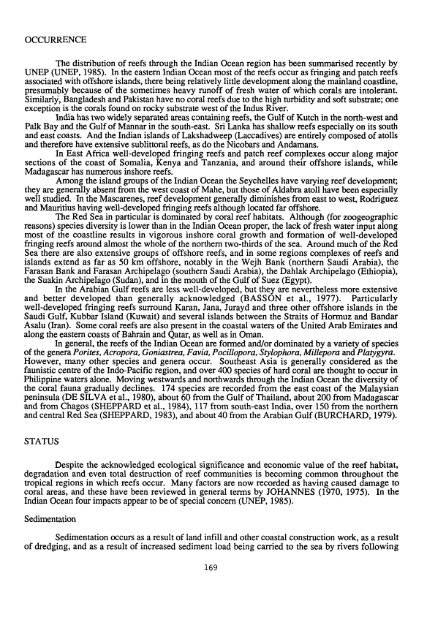139736eo.pdf (20MB) - Japan Oceanographic Data Center
139736eo.pdf (20MB) - Japan Oceanographic Data Center
139736eo.pdf (20MB) - Japan Oceanographic Data Center
- No tags were found...
You also want an ePaper? Increase the reach of your titles
YUMPU automatically turns print PDFs into web optimized ePapers that Google loves.
OCCURRENCEThe distribution of reefs through the Indian Ocean region has been summarised recently byUNEP (UNEP, 1985). In the eastern Indian Ocean most of the reefs occur as fringing and patch reefsassociated with offshore islands, there being relatively little development along the mainland coastline,presumably because of the sometimes heavy runoff of fresh water of which corals are intolerant.Similarly, Bangladesh and Pakistan have no coral reefs due to the high turbidity and soft substrate; oneexception is the corals found on rocky substrate west of the Indus River.India has two widely separated areas cmtaining reefs, the Gulf of Kutch in the north-west andPalk Bay and the Gulf of Mannar in the south-east. Sri Lanka has shallow reefs especially on its southand east coasts. And the Indian islands of Lakshadweep (Laccadives) are entirely composed of atollsand therefore have extensive sublittoral reefs, as do the Nicobars and Andamans.In East Africa well-developed fringing reefs and patch reef complexes occur along majorsections of the coast of Somalia, Kenya and Tanzania, and around their offshore islands, whileMadagascar has numerous inshore reefs.Among the island groups of the Indian Ocean the Seychelles have varying reef development;they are generally absent from the west coast of Mahe, but those of Aldabra atoll have been especiallywell studied. In the Mascarenes, reef development generally diminishes from east to west, Rodriguezand Mauritius having well-developed fringing reefs although located far offshore.The Red Sea in particular is dominated by coral reef habitats. Although (for zoogeographicreasons) species diversity is lower than in the Indian Ocean proper, the lack of fresh water input alongmost of the coastline results in vigorous inshore coral growth and formation of well-developedfringing reefs around almost the whole of the northern two-thirds of the sea. Around much of the RedSea there are also extensive groups of offshore reefs, and in some regions complexes of reefs andislands extend as far as 50 km offshore, notably in the Wejh Bank (northern Saudi Arabia), theFarasan Bank and Farasan Archipelago (southern Saudi Arabia), the Dahlak Archipelago (Ethiopia),the Suakin Archipelago (Sudan), and in the mouth of the Gulf of Suez (Egypt).In the Arabian Gulf reefs are less well-developed, but they are nevertheless more extensiveand better developed than generally acknowledged (BASSON et al., 1977). Particularlywell-developed fringing reefs surround Karan, Jana, Jurayd and three other offshore islands in theSaudi Gulf, Kubbar Island (Kuwait) and several islands between the Straits of Hormuz and BandarAsalu (Iran). Some coral reefs are also present in the coastal waters of the United Arab Emirates andalong the eastern coasts of Bahrain and Qatar, as well as in Oman.In general, the reefs of the Indian Ocean are formed and/or dominated by a variety of speciesof the genera Porites, Acropora, Goniastrea, Favia, Pocillopora, Stylophora, Millepora and Platygyra.However, many other species and genera occur. Southeast Asia is generally considered as thefaunistic centre of the Indo-Pacific region, and over 400 species of hard coral are thought to occur inPhilippine waters alone. Moving westwards and northwards through the Indian Ocean the diversity ofthe coral fauna gradually declines. 174 species are recorded from the east coast of the Malaysianpeninsula (DE SILVA et al., 1980), about 60 from the Gulf of Thailand, about 200 from Madagascarand from Chagos (SHEPPARD et al., 1984), 117 from south-east India, over 150 from the northernand central Red Sea (SHEPPARD, 1983), and about 40 from the Arabian Gulf (BURCHARD, 1979).STATUSDespite the acknowledged ecological significance and economic value of the reef habitat,degradation and even total destruction of reef communities is becoming common throughout thetropical regions in which reefs occur. Many factors are now recorded as having caused damage tocoral areas, and these have been reviewed in general terms by JOHANNES (1970, 1975). In theIndian Ocean four impacts appear to be of special concern (UNEP, 1985).SedimentationSedimentation occurs as a result of land infill and other coastal construction work, as a resultof dredging, and as a result of increased sediment load being carried to the sea by rivers following169
















